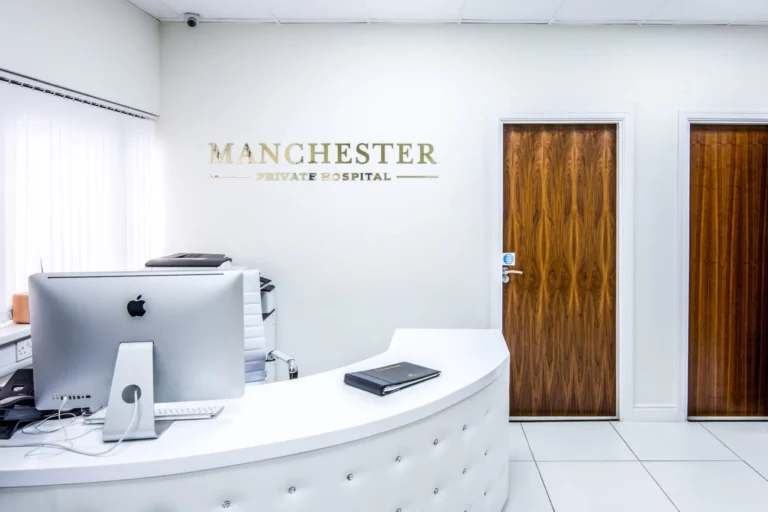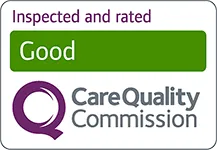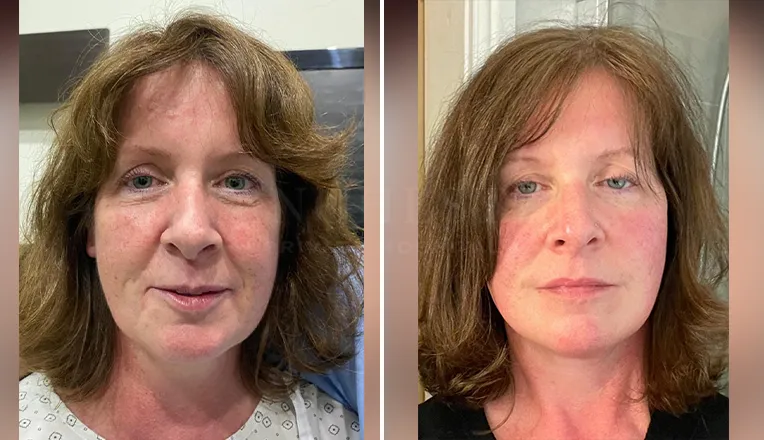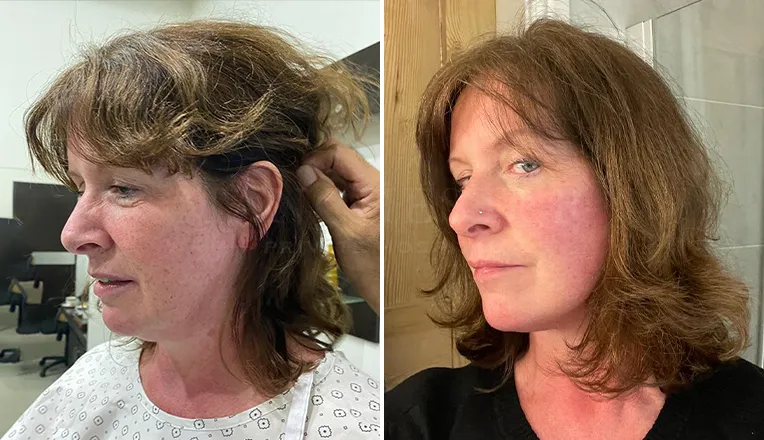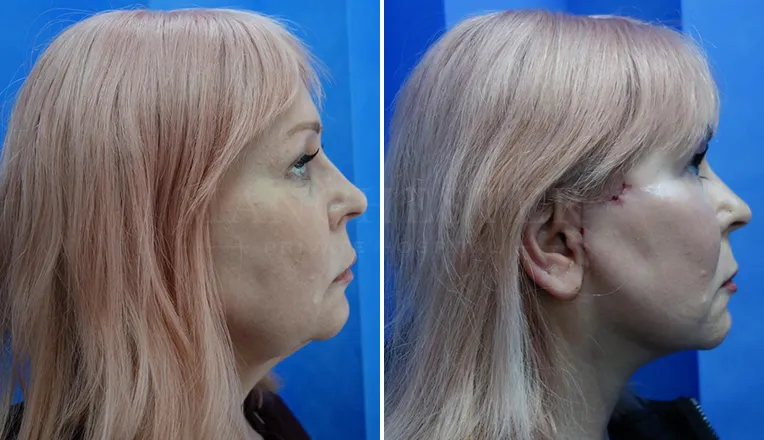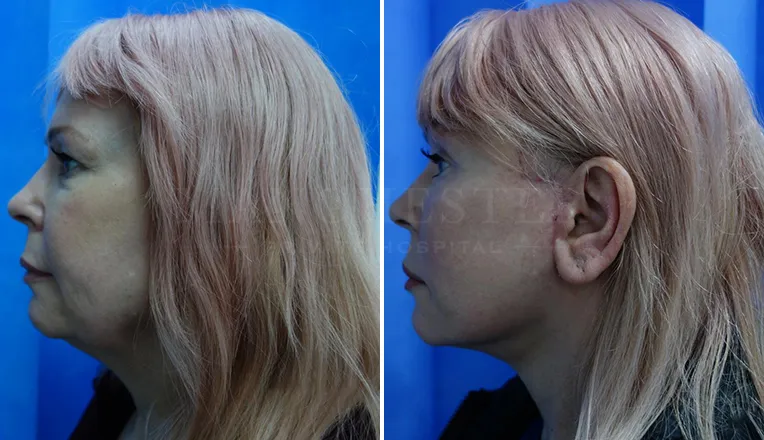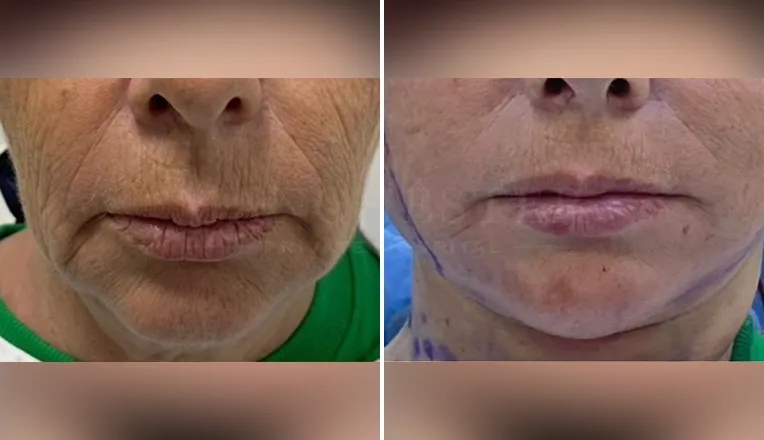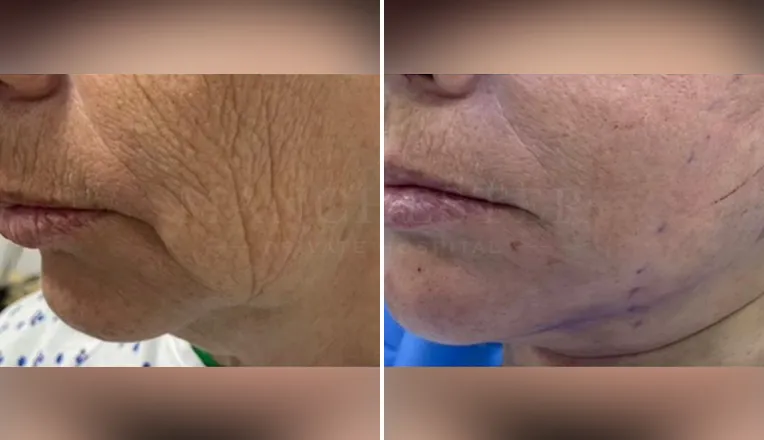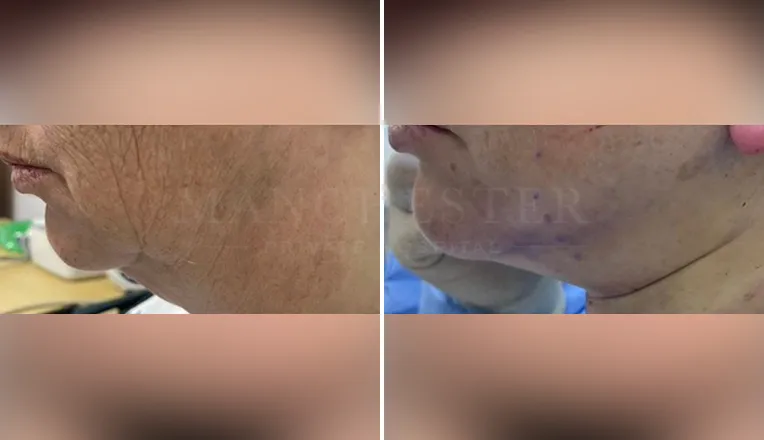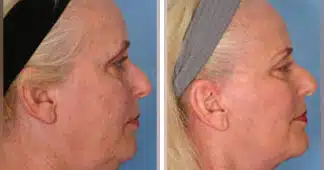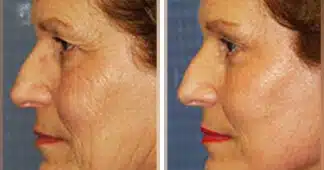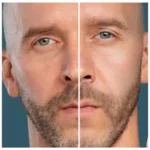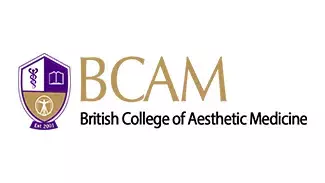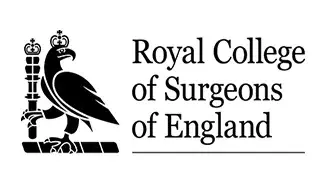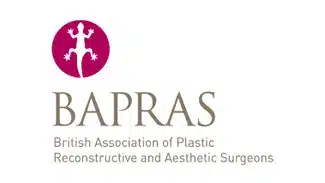Surgery Time
2-3 Hours
Results Seen
1-3 Months
Back To Work
1-2 Weeks
Pain Level
Moderate
HOSPITAL STAY
Overnight
Cost
On Consultation
Facelift In Manchester - Before And After Gallery
GMC Registered Surgeons
4000+ Happy Patients
Flexible Finance Options
CQC Registered Private Hospital
What Is Rhytidectomy?
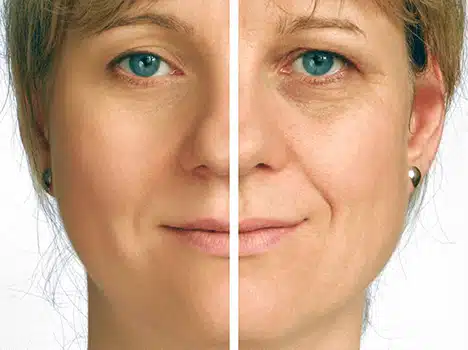
Rhytidectomy, also known as a facelift, is a cosmetic procedure that pulls and ‘lifts’ the skin on the face to make it smooth and tight.
This type of cosmetic surgery reduces saggy skin around the face and neck, including the jowls.
The aim of this procedure is to bring a more youthful look to the face by removing wrinkles.
Generally, a facelift involves removing excess skin on the face and tightening it, along with the underlying tissue. The surgery is commonly performed in combination with blepharoplasty, also known as eyelid surgery.
Facelifts are a common procedure in the cosmetic surgery world and one of the most popular surgeries performed in the UK.
Ageing is one of the most common reasons why people choose to have a facelift. Often the increase in facial lines, wrinkles and sagging skin makes people unhappy and reduces self confidence.
The surgery is available to both men and women, although more popular with women.
As the skin ages, it can lose its natural elasticity, particularly around the mouth, jowls and eyes. A facelift can rejuvenate the appearance of the face by reducing wrinkles and visible lines.
Why Have A Facelift?
People in the UK are choosing to have a facelift because they are unhappy with their facial appearance. Two of the most common reasons for undergoing rhytidectomy is ageing and weight loss.
Both getting older and losing weight can takes its toll on the face, particularly the skin. They can dramatically change the shape of the face and how it looks to others and in the mirror.
A facelift can increase self confidence and boost self esteem. It is known for making people look younger and patients often report feeling ‘rejuvenated’ and fresh.
In women who wear make-up, sagging skin can make it difficult to apply and cover / hide lines and wrinkles. Having tighter and more smooth skin following a facelift can mean application of make-up products is easier.
Because facelift surgery can involve the neck, it also improves the look and feel of the skin in this area, which means patients are able to wear clothes that they never used to be able to, such as low neckline clothing. It has been known that some women wear high neck clothing and scarves to hide ageing and sagging skin. Facelift can be a solution to this self-conscious issue.
About Facelift Surgery
A facelift is carried out by a professional facelift surgeon using general anaesthetic. You will be asleep for the entire procedure and therefore will not feel pain while it is carried out. Depending on the type of facelift and surgery involved, sometimes they can be performed using local anaesthetic instead along with the use of sedation.
There are generally 3 types of cosmetic procedures for a facelift:
- Traditional
- Keyhole
- MACS (Minimal Access Cranial Suspension)
Traditional
Traditional facelifts usually involve making an incision along your natural hairline that runs from behind your ear to the front of your ear.
Incisions are made carefully so that any scars will be hidden by your hair and natural lines on the face. After the recovery phase, scarring is minimal and fades to near-completely unnoticeable.
After the incision is made, your surgeon separates the skin from any underlying tissue and repositions the skin and any excess fat along with tightening the muscles in the face.
Skin that is lifted from the face will be pulled and stitched in to its new place and excess skin will be removed.
If patients opt for surgery on their jowls and neck, incisions are made underneath the chin.
If required, a surgeon can move fat and tissue from the face either completely or to a new place on the face.
A facelift takes around 3 hours to perform and a minimum of one night stay in hospital is required.
Following surgery, bandages are applied to the face. This helps to reduce swelling and minimise bruising. Read more about post-surgery in our recovery section below.
Keyhole
A keyhole facelift is performed by making very small cuts to the skin on your face.
Once the incisions are made, a telescopic camera is placed beneath the skin so that the surgeon can see the muscles and tissue that needs to be redistributed, tightened or removed.
This type of facelift is often carried out on the upper face and eye brows.
The recovery time is much less than a traditional facelift and there are usually less scars involved. However, not everyone is suitable for keyhole surgery and the results may vary depending on your goals and appearance. A professionally trained consultant will be able to advise you accordingly on whether you are suitable for keyhole surgery.
MACS
A MACS facelift, or Minimal Access Cranial Suspension is carried out using smaller, minimal incisions in the face.
MACS is popular for correcting saggy facial features. It does this by elevating the features by suspending them from above.
Scarring is less than a traditional facelift because of the minimally invasive incisions that are made in front of the ear instead of behind the ear. This means that scars are also easier to hide.
MACS procedures take less time to perform and there is less risk of nerve damage and bleeding. The recovery time is also significantly less than a traditional facelift.
If you are considering a facelift but are unsure which procedure is right for you, sitting down and discussing your needs with one of our consultants will provide you with all the necessary details you require about each method, and which one is most suited to you and your goals.
Recovery
On average, the recovery time from facelift surgery is between two and four weeks.
Patients often need to take at least 2 weeks off work for recovery and aftercare.
Depending on the type of facelift surgery that you undergo, you may see visible bruising for about 2 or more weeks post-procedure.
It is also worth noting that the time it takes to see the full effects of a facelift is around 6 to 9 months.
If you have any questions relating to the surgical procedure you are considering, speak with a specialist and arrange a consultation. During a consultation you will be able to find out answers to questions such as how many days you need to wait post surgery before driving, washing and showering arrangements and activities. Most people are advised to wait a minimum of 2 weeks before engaging in physical activity such as attending the gym or exercise classes.
Due to post-surgery swelling, patients are advised to prop up their head when sleeping and resting, which will help reduce swelling quicker and keep it to a minimum.
Side Effects And Complications
As with any surgical procedure, facelift surgery comes with some potential side effects and complications that you should be aware of.
Common side effects include:
- Bruising – Bruises tend to appear starting in the cheeks post-surgery and moving towards the neck as days pass.
- Numbness – Having a numb face is common. This may also be accompanied with stiffness and a puffy feeling around the affected areas.
- Scars – Visible scarring is a side effect with most cosmetic procedures. However, scars will fade with time, but may not completely disappear.
- Raised hairline – Some patients have a raised hairline, particularly at the incision areas.
Side effects are common in all patients. However, complications are rare but can still happen. These include:
- Haematoma – Blood can collect underneath the skin and may need to be removed.
- Nerve damage – Whilst feeling numb is a common side effect but is only temporary, permanent nerve damage can be permanent. Patients can lose some movement in their face and may experience a loss of sensation.
- Hair loss – Loss of hair can occur around incision areas.
- Thicker, more obvious scarring.
- Infection
- Blood clots
- Excessive bleeding
Complications with facelift surgery are rare. However, to discuss the likeliness and risks of complications in more detail, speak with your consultant.
Why Choose Us For Facelift?
At Manchester Private Hospital, we have been carrying out facelift procedures for many years in Manchester and surrounding areas.
Patients travel from all corners of the UK to undergo surgery by our experts, qualified surgeons who are highly skilled in cosmetic procedures.
We treat all patients professionally and personable on a case by case basis.
What’s more is, our consultations are pressure-free with absolutely no obligation, giving you a chance to find out all of the details you need and ask as many questions as you want.
Is Facelift Surgery Right For Me?
The best way to find out if facelift surgery is right for you is to meet with one of our cosmetic surgery professionals and discuss your needs.
However, you may be ideal for this type of surgery if you meet any of the following criteria:
- You have sagging skin on your face and loss of muscle definition.
- You have lines or creases at the side of the nose or mouth.
- You have jowls that droop or sag.
- You have a neck with sagging skin or a double chin.
If you are in good health and want to look younger whilst boosting your self confidence, contact us today to arrange a consultation with our facelift experts to help you achieve your goals.
Frequently Asked Questions
It is advised that a minimum of 1-2 weeks off work will be required to undergo surgery and ensure proper after care and recovery plans are in place.
In most cases, you will be put to sleep for facelift surgery via general anaesthetic. However, sometimes local anaesthetic and sedation can be used.
No. A facelift can make you look younger and more fresh, but it will not change the shape of your face.
Yes. Generally patients stay in hospital for 1 night following their surgery. But in some cases more than one night may be required.
Yes. Some patients undergo multiple procedures alongside a facelift, including neck lift, eyebrow lift and eyelid surgery.
0% Finance Available
Manchester Private Hospital have collaborated with Chrysalis Finance to offer 0% finance for our patients.*
- Face Lift and Neck Lift (GA/ONS) surgery starts from £12,500*
- Face Lift with lipo to chin (GA/ONS) surgery price on consultation
- Face Lift with upper or lower blepharoplasty (GA/ONS) surgery price on consultation
- Face Lift with upper and lower blepharoplasty (GA/ONS) price on consultation
*Acceptance is subject to status. Terms and conditions apply.
*Procedure prices are not fixed and may vary as procedure costs are tailored to individual requirements so vary from person to person. You will receive a guide price during your initial eConsult and a fixed price following your surgeon face to face consultation.
